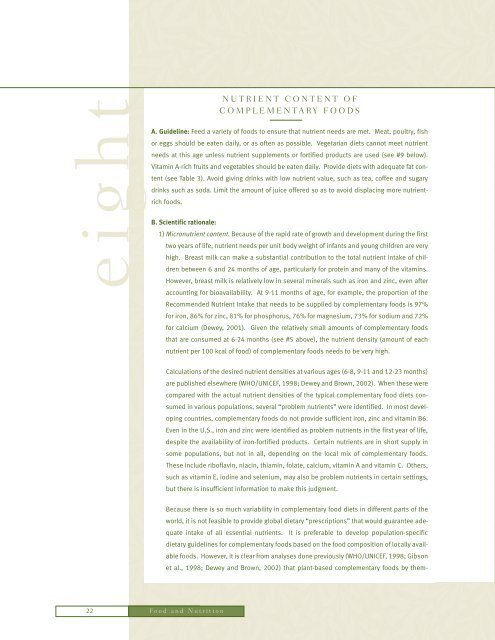Guiding Principles for Complementary Feeding of the Breastfed
Guiding Principles for Complementary Feeding of the Breastfed
Guiding Principles for Complementary Feeding of the Breastfed
You also want an ePaper? Increase the reach of your titles
YUMPU automatically turns print PDFs into web optimized ePapers that Google loves.
eight<br />
NUTRIENT CONTENT OF<br />
COMPLEMENTARY FOODS<br />
A. Guideline: Feed a variety <strong>of</strong> foods to ensure that nutrient needs are met. Meat, poultry, fish<br />
or eggs should be eaten daily, or as <strong>of</strong>ten as possible. Vegetarian diets cannot meet nutrient<br />
needs at this age unless nutrient supplements or <strong>for</strong>tified products are used (see #9 below).<br />
Vitamin A-rich fruits and vegetables should be eaten daily. Provide diets with adequate fat content<br />
(see Table 3). Avoid giving drinks with low nutrient value, such as tea, c<strong>of</strong>fee and sugary<br />
drinks such as soda. Limit <strong>the</strong> amount <strong>of</strong> juice <strong>of</strong>fered so as to avoid displacing more nutrientrich<br />
foods.<br />
B. Scientific rationale:<br />
1) Micronutrient content. Because <strong>of</strong> <strong>the</strong> rapid rate <strong>of</strong> growth and development during <strong>the</strong> first<br />
two years <strong>of</strong> life, nutrient needs per unit body weight <strong>of</strong> infants and young children are very<br />
high. Breast milk can make a substantial contribution to <strong>the</strong> total nutrient intake <strong>of</strong> children<br />
between 6 and 24 months <strong>of</strong> age, particularly <strong>for</strong> protein and many <strong>of</strong> <strong>the</strong> vitamins.<br />
However, breast milk is relatively low in several minerals such as iron and zinc, even after<br />
accounting <strong>for</strong> bioavailability. At 9-11 months <strong>of</strong> age, <strong>for</strong> example, <strong>the</strong> proportion <strong>of</strong> <strong>the</strong><br />
Recommended Nutrient Intake that needs to be supplied by complementary foods is 97%<br />
<strong>for</strong> iron, 86% <strong>for</strong> zinc, 81% <strong>for</strong> phosphorus, 76% <strong>for</strong> magnesium, 73% <strong>for</strong> sodium and 72%<br />
<strong>for</strong> calcium (Dewey, 2001). Given <strong>the</strong> relatively small amounts <strong>of</strong> complementary foods<br />
that are consumed at 6-24 months (see #5 above), <strong>the</strong> nutrient density (amount <strong>of</strong> each<br />
nutrient per 100 kcal <strong>of</strong> food) <strong>of</strong> complementary foods needs to be very high.<br />
22 Food and Nutrition<br />
Calculations <strong>of</strong> <strong>the</strong> desired nutrient densities at various ages (6-8, 9-11 and 12-23 months)<br />
are published elsewhere (WHO/UNICEF, 1998; Dewey and Brown, 2002). When <strong>the</strong>se were<br />
compared with <strong>the</strong> actual nutrient densities <strong>of</strong> <strong>the</strong> typical complementary food diets consumed<br />
in various populations, several “problem nutrients” were identified. In most developing<br />
countries, complementary foods do not provide sufficient iron, zinc and vitamin B6.<br />
Even in <strong>the</strong> U.S., iron and zinc were identified as problem nutrients in <strong>the</strong> first year <strong>of</strong> life,<br />
despite <strong>the</strong> availability <strong>of</strong> iron-<strong>for</strong>tified products. Certain nutrients are in short supply in<br />
some populations, but not in all, depending on <strong>the</strong> local mix <strong>of</strong> complementary foods.<br />
These include rib<strong>of</strong>lavin, niacin, thiamin, folate, calcium, vitamin A and vitamin C. O<strong>the</strong>rs,<br />
such as vitamin E, iodine and selenium, may also be problem nutrients in certain settings,<br />
but <strong>the</strong>re is insufficient in<strong>for</strong>mation to make this judgment.<br />
Because <strong>the</strong>re is so much variability in complementary food diets in different parts <strong>of</strong> <strong>the</strong><br />
world, it is not feasible to provide global dietary “prescriptions” that would guarantee adequate<br />
intake <strong>of</strong> all essential nutrients. It is preferable to develop population-specific<br />
dietary guidelines <strong>for</strong> complementary foods based on <strong>the</strong> food composition <strong>of</strong> locally available<br />
foods. However, it is clear from analyses done previously (WHO/UNICEF, 1998; Gibson<br />
et al., 1998; Dewey and Brown, 2002) that plant-based complementary foods by <strong>the</strong>m-

















